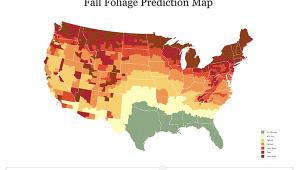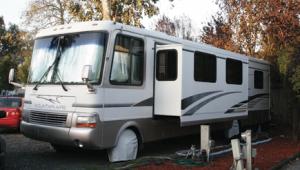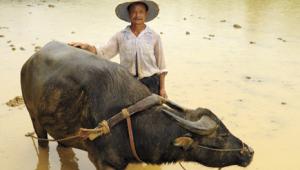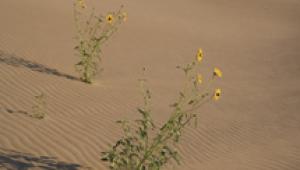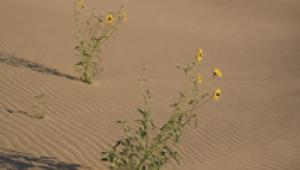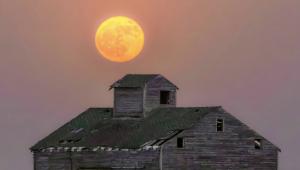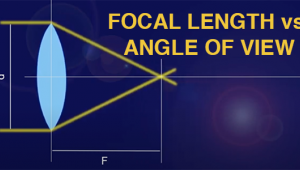A Natural Water World; Iguaz Falls, South America Page 2
From the Lower Circuit you can also access San Martin Island, reached by a two-minute boat ride across the river. The boat shuttle leaves every few minutes from either side. There is a short but steep trail on the island that will take you to a platform overlooking Salto San Martin, Salto Mbigua, and Salto Bernabé Mendez. The views will be from above, and the compositional possibilities are endless. A mid-telephoto lens would be ideal from the Isla San Martin Overlook, as it will allow you to make a variety of intimate compositions of different waterfalls. This overlook faces west, so mornings generally offer the best opportunity for good light.
Parque Nacional do Iguacu, Brazil
Although the Brazilian park is more compact than its Argentine counterpart,
it nevertheless offers striking views of the falls from its single, paved path;
the Brazilian side also offers a number of "safari"-type excursions,
including a jungle hike, jeep rides, and boat trips on the rapids of the Lower
Iguazú River. For a bird's eye view of the falls and surroundings,
you can take a helicopter flight from a helipad just outside the entrance to
the park, but keep in mind that these excursions have been found to disturb
the local wildlife (in fact, such flights are banned on the Argentine side).
Double-decker buses painted as different jungle animals shuttle visitors from
the park's main entrance to the start of the hiking path (the buses'
top deck is open and breezy, so get a seat here if you can). The path is about
a mile long and takes you high above the river, offering panoramic views of
the Argentine falls on the opposite side (best in the morning). As you walk
the path, look for different compositions of the river below and the Garganta
del Diablo upriver.
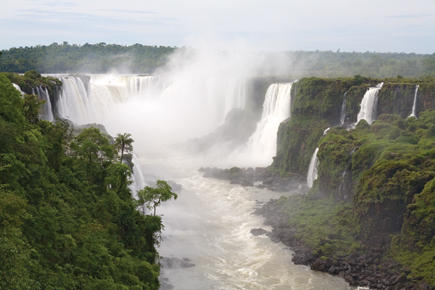 |
|
|
 |
|
|
From the main path, a metal walkway takes you right above the Salto Santa
Maria, and from here you can enjoy even better views of the Garganta del Diablo,
flanked by waterfalls and capped by a towering water plume. The path ends at
a large, multilevel viewing platform, complete with a souvenir shop, a snack
shop, an elevator connecting the different levels, and other facilities. The
platform's lower levels offer close-up views of the veil-like Salto Floriano,
while the top level will present you with an aerial view of the Upper Iguazú
River as it tumbles over rocky cliffs to the lower river.
A short distance from the trail's end you'll find a large platform
offering more views of the falls, a selection of fast food stands, a full-service
restaurant, and the buses' turnaround area (to return to the entrance).
If you have time and would like to see some of the local birds up close, pay
a visit to Brazil's Parque das Aves (Bird Park). Located about 300 yards
from the entrance to the park, the aviary is populated by a variety of birds
such as blue-black grosbeaks, parrots, and the always photogenic toucans.
 |
|
|
Gear And Tips
Much of your photography during your visit to the Iguazú Falls will be
done with a mid-telephoto lens in the 24-105mm range. As already mentioned,
extreme wide angle lenses can be problematic when shooting from a platform,
since you might "catch" the railing in your composition. If you
try to avoid this problem by placing the camera over the railing, be careful
not to go into the drink.
Longer zoom lenses in the 70-200mm range will be useful when composing more
intimate and semi-abstract renditions of the waterfalls. They also provide the
only way to get closer to the waterfalls from a number of overlooks.
Telephoto zoom lenses (300mm and longer) will come in handy when photographing
the local wildlife, although most of the birds in the area are small, fast,
and difficult to photograph. (The most easily photographed "wild"
animal is the coati, a diurnal member of the raccoon family; groups of them
regularly patrol the trails begging for food.)
In addition to the polarizing filter mentioned earlier, your photo bag should
include neutral density filters to obtain longer shutter speeds for that "silky"
water look.
You and your equipment will get wet while photographing the falls. I typically
combat wet conditions with a protective plastic cover and a soft cloth to wipe
down the lens and camera. If you have an assistant or companion with you, have
them hold an umbrella over your camera. And if conditions are windy, wait for
a lull in the wind before taking photos, then cover up when the wind returns.
To protect yourself, I recommend wearing a waterproof hat, jacket, and shoes.
However, you might want to shed your waterproof gear when hiking to and from
places, since conditions are usually warm and humid.
Finally, bring plenty of media cards and some sort of system to store and back
up your daily take (CDs, laptop, portable media storage devices, etc.), since
even a short visit to Iguazú Falls will provide for numerous and varied
photo opportunities.
If You Go
1. Both LAN Argentina (www.lan.com)
and Aerolineas Argentinas (www.aerolineas.com/ar)
offer daily, 11/2-hour flights from Buenos Aires to Puerto Iguazú, the
gateway city to Iguazú National Park. In Brazil, TAM Linhas Aéreas
(www.tam.com/br/) flies from São Paolo to Foz do Iguacu, gateway to the
Brazilian side of the falls. Before departure, ask your airline about weight
restrictions, and keep in mind that these will vary depending on which type
of ticket you purchase (more weight is allowed for, say, business class than
coach class passengers).
2. The relatively cooler months of March to November are considered the most
pleasant time to visit the falls. Running from May to July, the rainy season
features the falls at their most spectacular, especially after a heavy rain.
The most crowded times are during Easter and July.
3. Lodging options on both sides of the border range from camping to luxury
accommodations. Because of safety concerns, staying in Brazil's Foz do
Iguacu is not recommended. Instead most tourist hotels in the area are found
on the road leading to the park. In Argentina, staying in Puerto Iguazú
is an option, as the town offers a variety of accommodations (although it is
a little farther from the entrance to the park). As in Brazil, many of the hotels
in Argentina are on a road to the park. For a good website with lodging and
other information, visit www.latindestinations.com.
4. Crossing the border is easiest if you hire a cab driver who knows the requirements
and language (Brazilians speak Portuguese, Argentines Spanish). Typically the
driver will drop you off at the park and pick you up at an agreed-upon time.
He or she will also take care of all the border-crossing formalities. Hotel
personnel will be able to recommend a reliable driver.
5. The parks' hours are between 8am to 7pm in summer; the parks close
at 6pm in winter. Note that between November and February Brazil is one hour
ahead of Argentina, so plan accordingly if you are crossing borders during these
months. The entrance fees are about $10 per person per park, but the fee for
the Argentine park is about $5 the second (consecutive) day
you visit.
6. If you are traveling during the full moon, the Argentine park offers a special
after-hours tour that goes to the Garganta del Diablo. You can obtain more information
at the park's visitors center.
To see more of Efraín M. Padró's work, visit www.padroimages.com.
- Log in or register to post comments
